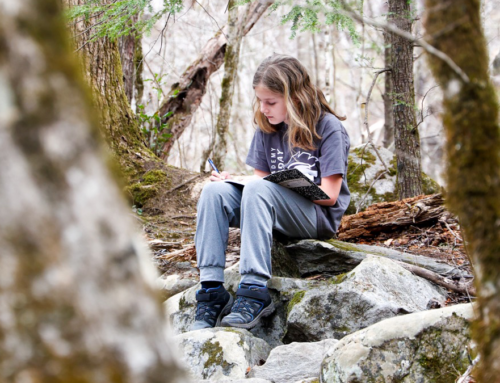Did you know that “a forest produces about a pound of dead leaves and wood per square yard every year?” (Brooke Friesen, Walking Mountains Science Center) The world around us is constantly decaying and regenerating, whether we see it or not. As investigators, you and your students can dive into the life cycle of your schoolyard to observe decomposers at work.
INVITE your students to investigate one of the most important parts of the life cycle by taking them on a time-lapse tour of a decaying forest floor. Start a discussion about the different organisms in the video and their roles in the life cycle. Brainstorm with your students about the different decomposers that they believe are present in the schoolyard.
EXPLORE your schoolyards for an area where students have a variety of organic materials open to them to investigate. Allow each group to choose a specific organic material (e.g. leaf material, seed pods, insects, etc) and search for each of its stages of decomposition, from fully grown to broken down into soil. Advise students to stay away from picking leaf material that is still on a tree or in the ground. This allows these plants to continue through their decomposition process.
WONDER about the speed of decomposition and how it speeds up or slows down, based on an object’s location in its environment. Pose questions to your students as they investigate the schoolyard: How can we show the same material at different stages of decomposition? Is there a higher density of decomposed materials underneath leaf litter or above it? Why? How can they tell? What are some examples of decomposers that would assist in the decomposition of these materials?
CREATE a chronological display of the materials that each student group chose. Having the students place the materials in chronological order will allow them to see the bigger picture of decomposition. The process of decomposition can become easier to understand when students see its different phases right in front of them.
SHARE Allow the students to present their group’s decomposition process to the rest of the class before going back inside. Students will be able to see different materials and how decomposition works on different materials. If you can, take pictures of each of the groups’ processes and display in your classroom, so that they will be available as references throughout the rest of the school year. Share photos of your students’ findings with Tremont, as well, so that we can compare and contrast what’s decomposing in your schoolyard with what’s decomposing in Great Smoky Mountains National Park! Share your results: Email [email protected].
Coordinating Academic Standards
Science
- 4.LS2.2 – Develop models of terrestrial and aquatic food chains to describe the movement of energy among producers, herbivores, carnivores, omnivores, and decomposers.
- 4.LS2.3 – Using information about the roles of organisms (producers, consumers, decomposers), evaluate how those roles in food chains are interconnected in a food web, and communicate how the organisms are continuously able to meet their needs in a stable food web.
- EVSC.LS2.4 – Compare and contrast production (photosynthesis, chemosynthesis) and respiratory (aerobic respiration, anaerobic respiration, consumption, decomposition) processes responsible for the cycling of matter and flow of energy through an ecosystem. Using evidence, construct an argument regarding the importance of homeostasis in maintaining these processes in ecosystems.
English Language Arts
- SL.PKI.4 – Present information, findings, and supporting evidence such that listeners can follow the line of reasoning; the organization, development, and style are appropriate to task, purpose, and audience.




![A Deep Dive Into Wetlands [Free Lesson Plan]](https://gsmit.org/wp-content/uploads/2024/02/madeline-blog-cover-500x383.png)
![Are You a Math and Science Person or a History and English Person? [Free Lesson Plan]](https://gsmit.org/wp-content/uploads/2024/01/Girls-in-Science-Erin-Rosolina-3-1-500x383.jpg)

